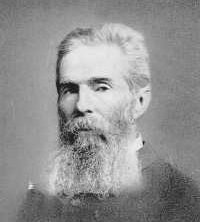 Herman Melville was born in New York City into an established merchant family. His father became bankrupt and insane, dying when Melville was 12. A bout of scarlet fever in 1826 left Melville with permanently weakened eyesight. He attended Albany (N.Y.) Classical School in 1835. He left the school and was largely autodidact, devouring Shakespeare as well as historical, anthropological, and technical works. From the age of 12, he worked as a clerk, teacher, and farmhand. In search of adventures, he shipped out in 1839 as a cabin boy on the whaler “Achushnet”. He later joined the US Navy, and started his year long voyages on ships. During these years he was a clerk and bookkeeper in a general store in Honolulu and lived briefly among the Typee cannibals in the Marquesas Islands. Another ship rescued him and took him to Tahiti.
Herman Melville was born in New York City into an established merchant family. His father became bankrupt and insane, dying when Melville was 12. A bout of scarlet fever in 1826 left Melville with permanently weakened eyesight. He attended Albany (N.Y.) Classical School in 1835. He left the school and was largely autodidact, devouring Shakespeare as well as historical, anthropological, and technical works. From the age of 12, he worked as a clerk, teacher, and farmhand. In search of adventures, he shipped out in 1839 as a cabin boy on the whaler “Achushnet”. He later joined the US Navy, and started his year long voyages on ships. During these years he was a clerk and bookkeeper in a general store in Honolulu and lived briefly among the Typee cannibals in the Marquesas Islands. Another ship rescued him and took him to Tahiti.
Typee was first published in Britain, like most of his works. Its sequel, Omoo (1847), was based on his experiences in Polynesian Islands and like its predecessor it gained a huge success. Throughout his career Melville enjoyed a rather higher estimation in Britain than in America. His older brother Gansevoort held a government position in London, and helped to launch Melville’s career. From his third book, Mardi and a Voyage Thither (1849), Melville started to experience the unpredictable turns of popular acclaim.
In 1847 Melville married Elisabeth Shaw, daughter of the chief justice of Massachusetts. After three yeas in New York, he bought a farm, “Arrowhead”, near Nathaniel Hawthorne’s home at Pittsfield, Massachusetts, and became friends with him for some time. Melville had almost completed Moby-Dick when Hawthorne encouraged him to change it from a story full of details about whaling, into an allegorical novel.
Inspired by the achievement of Hawthore, Melville wrote his masterpiece, Moby-Dick. When the novel was published, it did not bring him the fame he had acquired in the 1840s. Its brilliance was noted by some critics and very few readers. The narrator is Ishmael, who signs aboard the whaler Pequod with his friend Queequeg, a harpooner from the South Sea Islands. The mood of the story changes soon from the conventions of 19th-century comic realism. The reader is confronted by a plurality of linguistic discourses, philosophical speculations, and Shakespearean rhetoric and dramatic staging. Mysterious Captain Ahab appears after several days at sea. He reveals to the crew that the purpose of the voyage is to hunt and kill the white sperm whale, known as Mody-Dick, that had cost Ahab his leg on a previous voyage. The novel culminates when Moby-Dick charges the boat which sinks. Ahab is drowned, tied by the harpoon line his archenemy. The only survivor is Ishmael. Moby-Dick was misunderstood by those who read and reviewed it. Through Ishmael the author meditated questions about faith and the workings of God’s intelligence. He returned to these meditations in his last great work, Billy Budd, a story left unfinished at his death.
Pierre (1852), a Gothic romance and psychological study based on the author’s childhood, was a financial and critical disaster. Melville’s stories in Putnam’s Monthly Magazine reflected the despair and the contempt for human hypocrisy and materialism. Among the stories were ‘The Scrivener’ (1853), ‘The Encantadas’ (1854) and ‘Benito Cereno’ (1855).
The Confidence Man (1857), Melville’s last novel, was a harsh satire of American life set on a Mississippi River steamboat. After 1857 he wrote only poetry. To recover from a breakdown, he undertook a long journey to Europe and the Holy Land. Clarel (1876), a long poem about religious crisis, was based on this trip, and reflected his Manichean view of God. Subsequent works were privately printed and distributed among a very small circle of acquintances.
After unsuccessfull lecture tours in 1857-60, Melville lived in Washington, D.C. (1861-62). He moved to New York, where he was appointed customs inspector on the New York docks. This work secured him a regular income. Melville’s later works include Battle-Pieces and Aspects of the War (1865), privately printed John Marr and the Other Sailors (1888), and Timoleon (1891). Melville’s death on September 28, 1891, in New York, was noted with only one obituary notice. His unfinished work, Billy Budd, Foretopman, remained unpublished until 1924.
